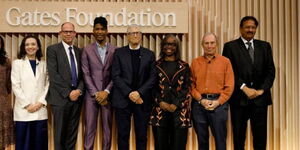The Head of the Catholic Church, Pope Leo XIV, on Sunday officially proclaimed seven new saints for the Church in a solemn canonisation ceremony at St Peter’s Square in Vatican City.
The event, attended by an estimated 55,000 faithful, was marked by prayers, hymns, and the reading of the canonisation formula in Latin, which formally declared the seven men and women as saints.
Among those canonised were Saint Ignatius Maloyan, an Armenian archbishop martyred during the 1915 genocide; Saint Peter To Rot, the first saint from Papua New Guinea who was killed for defending the sanctity of marriage; and Saint Vincenza Maria Poloni of Italy.
Others were Saint María Carmen Rendiles Martínez of Venezuela, Saint Maria Troncatti of Italy, Saint José Gregorio Hernández Cisneros of Venezuela, and Saint Bartolo Longo of Italy.
The ceremony, which took place in the Vatican, celebrated lives devoted to faith, service, and redemption, with three of the newly canonised being nuns remembered for their lifelong commitment to caring for the poor and the sick.
Ex-Satan Priest Canonised
Also joining the ranks of sainthood was Bartolo Longo, an Italian lawyer who had once been a priest of Satan before reconverting to Catholicism.
After returning to the Church, he dedicated his life to spreading devotion to the Virgin Mary and went on to found the Pontifical Shrine of the Blessed Virgin of the Rosary of Pompeii.
“Today we have before us seven witnesses, the new saints, who, with God’s grace, kept the lamp of faith burning,” Pope Leo XIV said in his homily. “May their intercession assist us in our trials and their example inspire us in our shared vocation to holiness.”
As he spoke, enormous portraits of the seven new saints were unfurled from the basilica’s windows, drawing applause and emotional cheers from the gathered faithful, according to AFP.
How is One Canonised
The canonisation process begins at the diocesan level, usually five years after the person's death, when the local bishop investigates their life, writings, and reputation for holiness.
Once sufficient evidence is gathered, the case is forwarded to the Vatican’s Dicastery for the Causes of Saints, and the individual is declared a Servant of God.
If the Vatican’s theologians and historians confirm that the person lived a life of 'heroic virtue', the Pope declares them Venerable, meaning the Church acknowledges their exemplary holiness but does not yet permit public veneration or worship.
The next step is Beatification, which requires a verified miracle attributed to the person’s intercession after death, except in the case of martyrs, who may be beatified without one. Upon beatification, the person is given the title 'Blessed' and may be publicly venerated in specific regions or communities.
Finally, canonisation takes place after a second miracle is confirmed, with the Pope then formally declaring the person a Saint during a public ceremony, issuing the canonisation formula.
This final stage allows universal veneration within the Church, with the newly canonised saint often given a feast day in the liturgical calendar.












